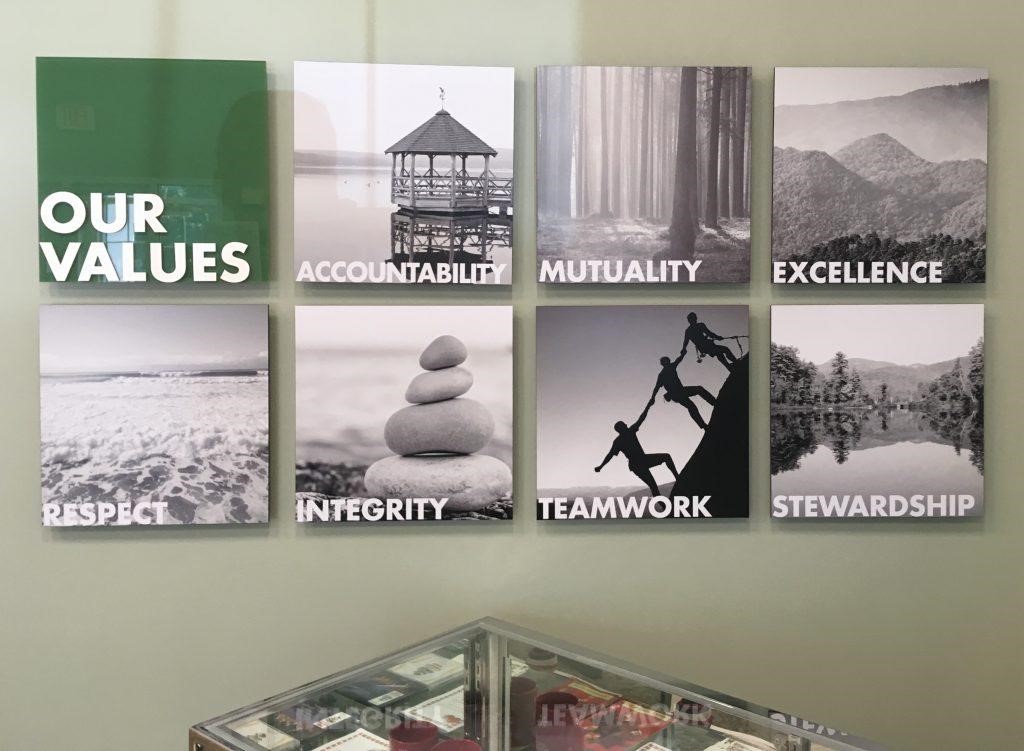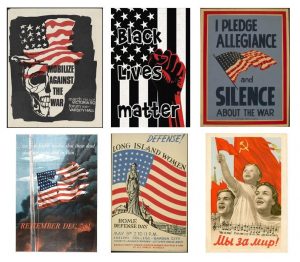8.4 Visual Rhetoric
Jennifer Schaller; Tammy Wolf; Tracey Watts; and Will Coviello
Below is a graphic display located in the lobby of a building. The display attempts to connect the key values of an organization to images, using visual rhetoric. Some of the instances are effective (“Teamwork”), while others don’t quite achieve the desired effect. Identify the images that work and those that fall short. For example, what does a gazebo dock have to do with accountability? Could the author have used an alternate image instead?

Visual Rhetoric Defined
Visual rhetoric is a special area of academic study unto its own. It has a long history in the study of art and semiotics (the study of symbols), and it is related to the classical study of oral rhetoric, which includes persuasive speeches and legal arguments. You may recall that rhetoric, more informally, can be understood as the practice of using language effectively to persuade. In speaking and in writing, effective rhetoric often relies on use of the appeals—pathos, ethos, and logos. Visual rhetoric works similarly. In the realm of visual rhetoric, images also use the appeals in order to communicate ideas and influence audiences.
For the purpose of our studies, we will define the phrase “visual rhetoric” as the means by which visual imagery can be used to achieve a communication goal. As in classical rhetoric, this goal is often to influence people’s attitudes, opinions, and beliefs. Visual rhetoric might be understood as the study of the impression that visuals make upon a viewer. We can examine many categories of images, including advertisements, photographs, political cartoons, and even memes, when studying this impact.
Visual imagery can often be symbolic, especially when the images represent concepts or values that have a common meaning in society. One example is the American flag. The American flag in an image frequently stands for patriotism, as in the United States Marine Corps War Memorial pictured below.

The sculpture depicted by this image is a three-dimensional interpretation of a historical photograph taken during World War II, which depicted six U.S. Marines raising an American flag on Mount Suribachi during the Battle of Iwo Jima. The original photograph, which won a Pulitzer Prize in 1945, is widely recognized as an iconic World War II image. In the photograph, as in the later sculpture, the American flag conveys a sense of hope, enduring effort, and patriotism.
The political cartoon below, published in 2020, makes a clear reference to the Iwo Jima photograph in order to highlight the heroic sacrifices of healthcare workers, whom the cartoon compares to U.S. Marines.

The culture we live in influences our responses to images, and even within a shared culture, people from different groups might interpret images differently. While the Iwo Jima photo, the USMC War Memorial, and the 2020 political cartoon all convey a meaning that most viewers can comprehend with little disagreement, it is possible for people from different backgrounds to react to and use images in opposing ways. A national flag, for example, as shown in the images that follow, can be used to emphasize the patriotism of an action or event. It can be used to critique a moment in which actions fall short of patriotic ideals.
The context of an image is also important. The author of visual media, just like a writer working with written text, needs to provide readers with additional information about what an image relates to in order for the image to produce its intended effect. In other words, a picture of a flag, in isolation, may not convey a clear meaning. It is up to the author to surround the image with enough information (text or speech) so that the reader can form the connections between the image and the message that the author intends to convey.
We can explore this concept by analyzing specific images. The examples below depict flags to convey a variety of distinct messages. Some of the messages are designed to align with the conventional perception of the national flag. These messages convey a sense of patriotism, duty, or idealism. Other examples use the flag as a commentary on an event that stands in opposition to the ideals that the flag traditionally represents. The reader understands the message at a glance without much cognitive deliberation—because that is the natural reflex of human visual sensory perception.
How might you describe the message of each image below? Which images use the flag to send traditional messages about patriotism? Which images make protests? How would you describe the message that each image sends? How would you describe the values that the creator of each image might embrace?

The vocabulary of visual rhetoric is already familiar to readers who have studied the rhetorical appeals:
- Logos: An appeal to logic meant to convince an audience by use of logic or reason.
- Pathos: An emotional appeal meant to persuade an audience by appealing to their emotions.
- Ethos: An ethical appeal meant to convince an audience of the author’s credibility or character.
This video offers a more in-depth review of the rhetorical appeals.
We can analyze many categories of images when we examine visual rhetoric in practice. Advertisements are a class of images that we see on a daily basis, and we interact with their visual rhetoric perhaps without even realizing that we are doing so. Advertisements frequently use rhetorical appeals in order to connect with specific audiences, whom they target as potential customers. In the print ad below for Pinnacle Bank, the image shown has no relationship to banking itself. However, the image works to persuade the viewer that the bank has ethos, or credibility, by using images that the bank hopes will attract a specific demographic of individuals or businesses. Who do you think the target audience for the ad may be? Can you identify values that the target audience might embrace? How does the bank use imagery to build credibility among a target audience?

In this ad, Pinnacle Bank has selected a farm image, as opposed to a bank image, in order to acknowledge the audience’s interests, traditions, and livelihood. In doing so, the bank hopes to promote feelings of trust, connection, and mutual understanding, even though the occupations of banker and farmer couldn’t be more different.
In developing a thorough analysis of how visual objects, such as advertisements and political posters, use rhetorical devices, we might ask the following questions:
- Message: What overall argument is the image or visual text trying to make? We can usually determine the message of an item based on visual clues, including the interaction between visual details and written text.
- Purpose: Are there specific goals or outcomes that the creator of the item may be trying to reach? There is often quite a bit of overlap between message and purpose, but key distinctions between these two categories can be made as well. In the case of advertisements, the purpose is often to expand the consumer base. However, in some advertisements, especially contemporary ads, the purpose might involve rebranding or sending a political message.
- Context: Are there historical or cultural details that we should recognize as important to the message? In analyzing an advertisement, should we be aware of the brand’s pre-existing reputation or its prior advertising campaigns? Many corporations repeatedly emphasize specific core values in their advertising. Others update their strategies and messages over time. Political and cultural messages may be apparent in visual images as well, whether overtly or in subtle ways.
- Details: What should we notice about the concrete, visual aspects of the item? What choices were made regarding color or font, for example? What choices were made in the writing of the individual lines of text or dialogue? Are there certain details about the characters in the image that stand out?
- Problems: Does the item have blind spots? Does it mischaracterize or misunderstand certain characters or themes? Does it make assumptions that may be problematic or culturally insensitive?
We might use this 2015 video from Mattel, titled “Imagine the Possibilities,” to put these concepts into practice. In the ad, Mattel sends a message that playing with Barbie dolls can help young girls imagine themselves as successful professionals. The purpose of the ad isn’t just to sell more Barbies, though doing so is certainly part of the plan. In addition to boosting sales, Mattel is likely hoping to rebrand the toy by moving away from the stereotype of Barbie dolls as superficial and materialistic.
We can develop context by noting that earlier decades saw the company focusing on advertising more materialistic, luxury items, such as Barbie’s Dream House. However, in the 21st century, our culture has become more wary of narratives that depict women largely as housewives. In response, Mattel’s advertisement shows the brand moving toward a focus on women’s career prospects. In “Imagine the Possibilities,” the five young female actors imagine themselves as working professionals.
We can take a close look at the details of the ad to note that the young girls are succeeding in fields that have traditionally been male dominated. Three girls work in STEM-related fields; one is a biology professor, another is a vet, and the third is a museum docent working in the field of paleontology. One of the other two girls is a coach for a men’s soccer team. The other is a CEO. While Mattel is clearly working to appeal to consumers who want their daughters to break the glass ceiling, the ad does have some problems. The girls are frequently given silly lines that emphasize their naivete. Additionally, the girls working in the sciences offer incorrect “facts” that children their age should know. Ultimately, one gets the sense that Mattel wants to empower these girls—but hasn’t quite figured out how to do so. The ad also lacks diversity. While many of the secondary actors in the ad are people of color, the ad is much less inclusive in its casting of the primary actors.
Exercise
Many brands work to communicate a set of core values in their advertisements over time. Coca-Cola, for example, often aims to link its products to concepts like patriotism or unity. Watch the ads linked below and examine how each sends the message that Apple products offer people a sense of individuality and freedom. As you discuss the ads, try to identify exactly what Apple is offering people freedom from. Does Apple’s emphasis on freedom reflect the nature of the relationship that you have with products like the ones that Apple offers?
“1984”
“Homework”
“Bounce”
Attribution: Sections of this chapter were created by Jennifer Schaller and Tammy Wolf in their free textbook, Introduction to College Writing at CMN. It is licensed under CC BY-SA 3.0.
Sections of this chapter were created by Steve Covello in his free textbook Visual Communication (link via WayBack Machine) licensed under CC NC-SA 4.0. Editing, re-mixing, and supplemental original content by Dr. Tracey Watts as part of the LOUIS Interactive OER for Dual Enrollment project, 2022. It is licensed under a CC-BY NC SA 4.0 International license. ![]()

